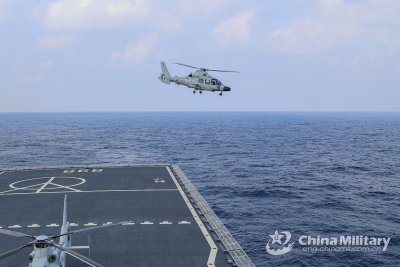China dispatched a military helicopter to disputed waters and jammed the tracking systems of Philippine ships in the area to keep them from broadcasting their locations, the Philippine Coast Guard has claimed.
The incident allegedly took place around Scarborough Shoal, which sits about 120 miles from the Philippine province of Luzon and nearly 700 miles from the Chinese mainland.
U.S. ally the Philippines says it is increasing coast guard and fisheries bureau patrols at the atoll, which China effectively seized in 2012, to support the livelihoods of local fishermen who rely on their catches at the rich fishing grounds.
Philippine Coast Guard spokesperson Jay Tarriela said at a press conference that the helicopter seen flying over Scarborough Shoal was painted military grey, as opposed to coast guard white, and bore Chinese characters translating to "Chinese Navy."
Newsweek reached out to the Chinese embassy in the Philippines with a written request for comment.
"This is the first time that we have sighted this kind of aircraft in the area," Tarriela said of the helicopter, which appeared to be a Harbin Z-9. China's coast guard also operates Z-9s, though likely outfitted with different equipment than those of the navy.
"I foresee a stronger PRC (People's Republic of China) effort to revise the status quo and establish effective control and exclusive presence in the Scarborough Shoal, but it will be a tough balancing act for them," Jeffrey Ordaniel, associate professor at Tokyo International University and senior researcher with the Honolulu-based Pacific Forum think tank, told Newsweek when asked about the helicopter.
Ordaniel said the Philippines' current policy of using transparency to document the territorial dispute poses a challenge to Beijing.
"On the one hand, they want Philippine vessels out of the shoal. On the other hand, doing so could mean bigger reputational costs, especially since independent news media are almost always embedded on Philippine Coast Guard ships," he said.



In the face of China's overwhelming economic and military advantage, the Philippines has been conducting a name-and-shame campaign against Chinese maritime forces that enter its internationally recognized exclusive economic zone (EEZ).
This has included allowing journalists aboard government vessels so they can share footage of aggressive Chinese reactions, such as blocking maneuvers and water cannon deployment, with the international community.
China claims sovereignty over nearly all of the heavily trafficked South China Sea, putting it at odds with the Philippines and other neighboring countries with territorial claims, including Vietnam, Malaysia, Indonesia, Brunei, and Taiwan.
About the writer
Micah McCartney is a reporter for Newsweek based in Taipei, Taiwan. He covers U.S.-China relations, East Asian and Southeast Asian ... Read more



